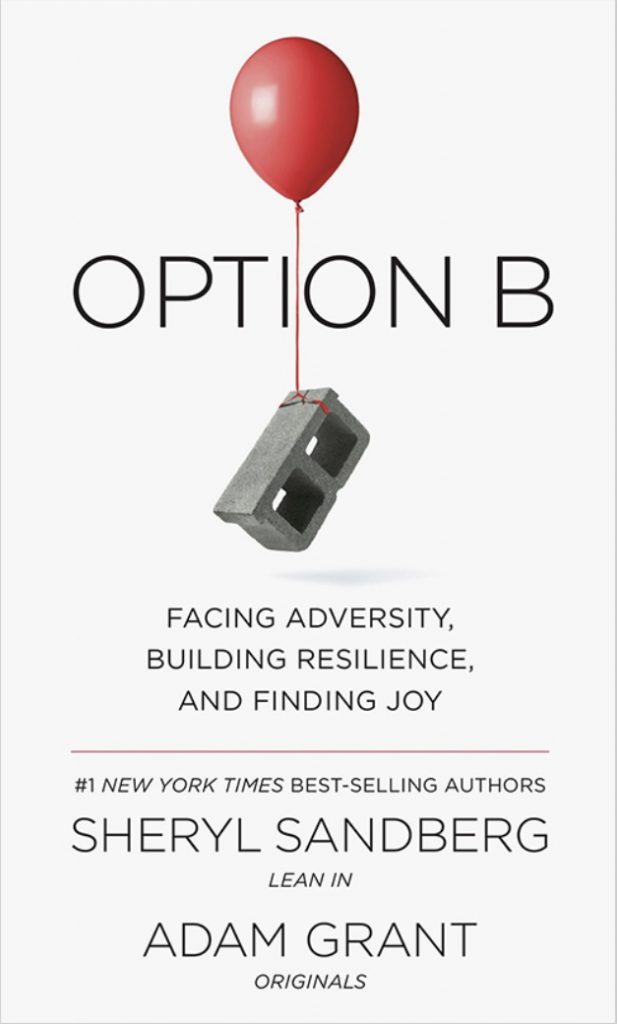Key Quote:
“We find our humanity—our will to live and our ability to love—in our connections to one another. Just as individuals can find post-traumatic growth and become stronger, so can communities” (p. 141). — Sheryl Sandberg
Key Points and Concepts
The Three P’s
Psychologist Martin Seligman found three things that stunt people’s ability to recover from traumatic events: personalization, pervasiveness, and permanence (p. 16).
• Personalization is blaming yourself for an incident, or the belief that you are at fault. Sandberg thought her husband’s death could have been avoided if she had been there with him and constantly apologized to everyone for his loss. Grant advised Sandberg to stop saying “I’m sorry” or “I apologize” for the disruption in everyone’s life around her, which, in return, helped her stop putting the blame of his death entirely on herself (pp. 16-18).
• Pervasiveness is the belief that something will affect all aspects of one’s life (p. 16). Sandberg was convinced that she would never be able to return to work again, go to her children’s activities, or even make it through dinners with friends after Dave’s death. As she found the courage to do so, she said routine activities made her feel better. Sandberg suggests that people return to their daily routine as soon as possible (p. 19).
• Permanence is the belief that aftershocks of a traumatic event will last forever (p. 16). Sandberg worried that the anguish of her husband’s death would always be present in her mind, but studies show that if people overestimate how a negative event will affect them, it turns out more poorly then if they had tried to be positive from the start (p. 21). Banishing words like “never” and “always” and replacing them with “sometimes” and “lately” is a good start to realizing feelings won’t last forever (p. 21).
Acknowledging the Elephant
After her husband’s death, Sandberg noticed friends avoided asking her how she was doing and instead made small talk with her to fill the void, but studies show that even those who have endured the most suffering still want to talk about it (p. 32). Sandberg explains: “Until we acknowledge it, the elephant is always there. By ignoring it, those who are grieving isolate themselves and those who could offer comfort create distance instead. You can’t wish the elephant away, but you can say, ‘I see it. I see you’re suffering. And I care about you’” (p. 44).
Misery invites misery. Sandberg remembers feeling comforted at Dave’s funeral when a friend said, “my dad died when I was four,” rather than saying “sorry for your loss.” Sandberg said she felt hope for her kids knowing that her friend had turned out okay after going through something similar (p. 35).
Bruce Feiler, New York Times bestselling author, advises those who want to help not to offer to do “anything,” but to just do “something” specific (p. 51). Sandberg recalls a story of doing “something” when a friend whose child was sick in the hospital was asked by a friend of his,
“what do you NOT want on a burger?” (p. 51).
Tell people you are in it with them, not that they will be okay (p. 56).
Practicing Self-Compassion and Self-Confidence
“Self-compassion often coexists with remorse. It does not mean shirking responsibility for our past. It’s about making sure that we don’t beat ourselves up so badly that we damage our future…Instead of thinking, ‘if only I weren’t,’ we can think, ‘if only I hadn’t’” (p. 61).
Writing can be a tool for self-compassion. Psychologist Jamie Pennebaker asked college students to journal for 15 minutes a day. Those who wrote about traumatic experiences felt happier and had healthier rates of blood pressure after a few days of studies (p. 62).
When journaling, be specific. Sandberg advises putting feeling into words. Instead of saying “I feel awful,” be more specific with your label and say, “I’m feeling lonely” (p. 63).
Sandberg remembers her confidence being shot after Dave’s death. Grant suggested she write down things she did well each day, including miniscule tasks like being able to pay attention in a meeting or going through all of her emails. By writing down small contributions, Sandberg found she was able to focus on things that she had done right instead of things she’d done wrong (p. 68).
Don’t look for joy in big moments like graduations, birthdays, having a child, etc., but instead seek it out in small things that you enjoy doing (p. 100). Practice writing about joyful experiences, too. Studies show doing so for just three days improves mood and decreases visits to health centers.
Post-Traumatic Growth
Grant told Sandberg that more than half of people who experience a traumatic event can report at least one positive change after (p. 79).
“What does not kill me makes me stronger” (p. 79).
Post-traumatic growth can take five different forms: finding personal strength, gaining appreciation, forming deeper relationships, discovering more meaning in life, and seeing new possibilities (p. 79).
“Although it can be extremely difficult to grasp, the disappearance of one possible self can free us to imagine a new possible self. After tragedy, we sometimes miss these opportunities because we spend all of our emotional energy wishing for our old lives” (pp. 91-92).
When Sandberg’s friend, Joe Kasper, lost his son at a young age, he was able to recover from the death by realizing his actions could be part of his son’s legacy. Kasper created Co-Destiny for grieving parents not to view their child’s death as the end of their story. Kasper explains, “I realized that my destiny was to live my life in a way that would make my son proud. The awareness that I could add goodness to my son’s life by doing good in his name motivates me to this day” (p. 92).
Raising Resilient Children
Sandberg admits that after Dave died, her biggest concern was her children’s happiness. On her way home from Mexico, she called her friend who counsels grieving children and was advised on how to tell her kids: simply, directly, and to reassure them that most aspects of life would go on as they always had (p. 109).
Grant told Sandberg that resilience is not a personality trait but rather, a lifelong project. This can be started by helping children develop four core beliefs: they have some control over their lives, they can learn from failure, they matter as human beings, and they have strengths to rely on and share (p. 111).
A study tracked at-risk children who grew up in environments of severe poverty, alcohol abuse, or mental illness for three decades. Many of the kids matured into “competent, confident, and caring young adults” because they knew they had a sense of control over how their lives turned out (p. 111).
Sandberg thinks it’s important to raise kids with a growth mindset. “When parents treat failure as an opportunity to learn rather than an embarrassment to be avoided, kids are more likely to take on challenges” (p. 114).
Knowing that someone notices, cares, and relies on you helps children know that they matter (p. 115). In Denmark, schools have a dedicated hour to “Klassen time,” where children present their own problems, feel listened to, and can guide their classmates to feeling good about their own problems (p. 116).
Resilient kids also have strengths they can use to help themselves and others. Girls First, a program for girls in India, teaches girls different strengths of character that range from courage to gratitude. Girls First found that those who participated for just one hour a week believed their emotional resilience was stronger than before and the girls that had intervened in more conflicts had better outcomes than prior to joining the program (p. 117).
Collective Resilience
“We find our humanity—our will to live and our ability to love—in our connections to one another. Just as individuals can find post-traumatic growth and become stronger, so can communities” (p. 141).
Collective resilience is resilience built not just in individuals, but among them. It allows everyone to become stronger, prevent obstacles, and avoid further adversity (p. 130). To join a community, writer Allen Rucker said one must accept their new identity (p. 131). For Sandberg, that meant accepting that she was a widow (p. 132).
“Stereotype threat” is the fear of being reduced to a negative stereotype and often turns into a self-fulfilling prophecy, but Sandberg notes it’s important to change the narrative to positive associations (p. 134).
Researchers have said that believing in possibilities or ‘grounded hope,’ the belief that you can take actions to make things better, helps people move forward from tragedy (p. 129). When a plane in 1972 crashed, survivors were left to fend for themselves for 72 days. Amazingly, 14 of the victims survived. One survivor, Roberto Conessa said, “Some people say if there’s life, there’s hope. But for us, it was the opposite: If there’s hope, there’s life” (p. 128). Sandberg says hope keeps people from giving in to despair.
Sandberg, S., & Grant, A. (2017). Option B: Facing Adversity, Building Resilience, and Finding Joy. New York: Knopf.

“We find our humanity—our will to live and our ability to love—in our connections to one
another. Just as individuals can find post-traumatic growth and become stronger, so can
communities” (p. 141).
“Misery invites misery. Sandberg remembers feeling comforted at Dave’s funeral when a friend said, “my dad died when I was four,” rather than saying “sorry for your loss.” Sandberg said she felt hope for her kids knowing that her friend had turned out okay after going through something similar.”
“Post-traumatic growth can take five different forms: finding personal strength, gaining appreciation, forming deeper relationships, discovering more meaning in life, and seeing new possibilities.”
“We find our humanity—our will to live and our ability to love—in our connections to one
another. Just as individuals can find post-traumatic growth and become stronger, so can
communities.”
